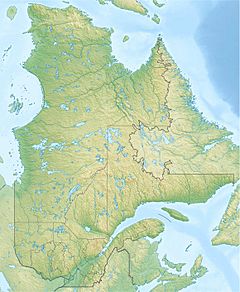Filkars River facts for kids
Quick facts for kids Filkars River |
|
|---|---|
| Native name | Rivière Filkars |
| Country | Canada |
| Province | Quebec |
| Administrative region | Chaudière-Appalaches |
| RCM | Lotbinière Regional County Municipality |
| Physical characteristics | |
| Main source | Mountain streams Saint-Sylvestre 490 metres (1,610 ft) 46°19′42″N 71°09′26″W / 46.328279°N 71.157247°W |
| River mouth | Beaurivage River Saint-Patrice-de-Beaurivage) 151 metres (495 ft) 46°25′12″N 71°17′47″W / 46.42°N 71.29639°W |
| Length | 30.2 kilometres (18.8 mi) |
| Basin features | |
| Progression | Beaurivage River, Chaudière River, St. Lawrence |
| Tributaries |
|
The Filkars River (also known as rivière Filkars in French) is a river in Quebec, Canada. It flows into the Beaurivage River, which then joins the Chaudière River. Finally, the Chaudière River empties into the mighty St. Lawrence River.
The Filkars River runs through several towns. These include Saint-Sylvestre, Sainte-Agathe-de-Lotbinière, and Saint-Patrice-de-Beaurivage. All these places are in the Lotbinière Regional County Municipality, which is part of the Chaudière-Appalaches region of Quebec.
Contents
Filkars River: A Journey Through Quebec
The Filkars River is an important part of the local water system. It helps carry water from smaller streams and lakes to larger rivers.
Where Does the Filkars River Flow?
Rivers are part of a larger system called a watershed or drainage basin. This is an area of land where all the water flows to a common outlet, like a river or a lake. The Filkars River's watershed is connected to many other rivers.
Some of the main rivers near the Filkars River's path include:
- To the north: rivière du Chêne, Henri River, and the Beaurivage River.
- To the east: Saint-André River, Fourchette River, Nadeau River, Lessard River, and the Chaudière River.
- To the south: Bécancour River, Palmer River, and the Palmer East River.
- To the west: Armagh River and the Bécancour River.
The River's Journey: From Start to End
The Filkars River starts its journey from a small lake. This lake is high up, about 490 metres (1,610 ft) above sea level. It's located in the southeastern part of Saint-Sylvestre. The starting point is near a place called "Le Radar," close to some mountains like Mont Handkerchief and Mont Sainte-Marguerite.
The river flows for about 30.2 kilometres (18.8 mi) in total. Let's look at its path in two main parts:
The Upper Part of the River
The first part of the river's journey covers about 21.9 kilometres (13.6 mi).
- It begins by flowing northwest from its small lake source.
- Then, it turns west, crossing Route 216 near the village of Saint-Sylvestre.
- It continues west, crossing Route 269 north of the Wilson hamlet.
- The river then heads northwest, reaching the border of the Sainte-Agathe-de-Lotbinière area.
- Finally, in this upper section, it flows north and meets the Armagh River, which comes from the west.
The Lower Part of the River
After joining the Armagh River, the Filkars River flows for another 8.3 kilometres (5.2 mi).
- It turns northeast, collecting water from the Saint-André River (which comes from the southeast). The river winds quite a bit in this section, reaching the border of Saint-Patrice-de-Beaurivage.
- It then flows east for a short distance.
- Next, it continues northeast, picking up water from the Fourchette River (from the southeast). It keeps winding until it reaches the "route du Petit Lac."
- The river then flows northeasterly, crossing Route 269 one more time.
The Filkars River eventually empties into the Beaurivage River. This meeting point is about 4.5 kilometres (2.8 mi) west of the village of Saint-Patrice-de-Beaurivage.
How Did the River Get Its Name?
The name "Filkars" likely comes from "Felker's," meaning "owned by Felker." This name is linked to a landowner named David Felker. He lived in Saint-Sylvestre between 1824 and 1839 and was originally from New Hampshire.


